Will it or won’t it? That’s the burning question on many birdwatchers’ lips just now – will it or won’t it be a waxwing winter?
Just take one look at the waxwing and it is easy to see why this is a bird that stirs such frenzied excitement. It is a truly exquisite beauty with chestnut crested head, black facemask and chin, soft pinkish plumage and intricately patterned wing edges. Oh, and then there is that tail tipped with yellow. This is a true ‘A’ lister, a bird to make you gasp.
When I once saw a flock of waxwings in a rowan tree in Glasgow it was enough to bring my car to a juddering stop and a wheel-spinning reverse to bring the birds back into view. That’s what waxwings do to people.
They are rather scarce visitors to our shores, which no doubt adds to their intrigue. Waxwings breed in the remote pine forests of northern Scandinavia and Russia. In autumn and winter they feed on berries, and the relative abundance of the berry crop depends on whether they hit our shores or not. If the berry crop in northern Europe is not large enough to support the population, then in they come.
This means you can get several winters on the trot with very few waxwings about, to be then followed by an invasion year. Courier Country is a great place to see waxwings because they’ll make first landfall on the east coast. And because they like berries, some of the best places to see them are gardens and parks in cities such as Dundee and Perth.
Last week as I made my way along a path by the edge of the River Devon I came across a scene out of Africa. In a nearby field there were jackdaws riding on the backs of grazing sheep in a similar manner to how oxpecker birds cling to the hides of African buffalo to feed upon ticks and other skin parasites.
These jackdaws were doing exactly the same thing and meticulously combed their beaks through the woolly backs of the sheep in search of nutritious morsels. It is a mutually beneficial arrangement and it looked to me that the sheep were positively enjoying the close grooming attention of the jackdaws.
Jackdaws are one of those birds that tend to get overlooked, which is a pity for they are fascinating creatures. I once had a friend who owned a pet jackdaw and it soon became apparent to me that this was a bird with intelligence and an insatiable curiosity for investigating new things.
They say curiosity killed the cat and in nature such instincts can be a double edged sword. It is the bold that will be rewarded with new food sources, but sometimes taking a risk can be a fatal mistake. Most birds and animals adopt the cautious approach, but not so the jackdaw, it just can’t help sticking its beak into where others fear to tread.
Info
The waxwing is slightly smaller than a starling. Look out for them feeding on berries in rowan, guelder rose, holly and cotoneaster trees and bushes.










